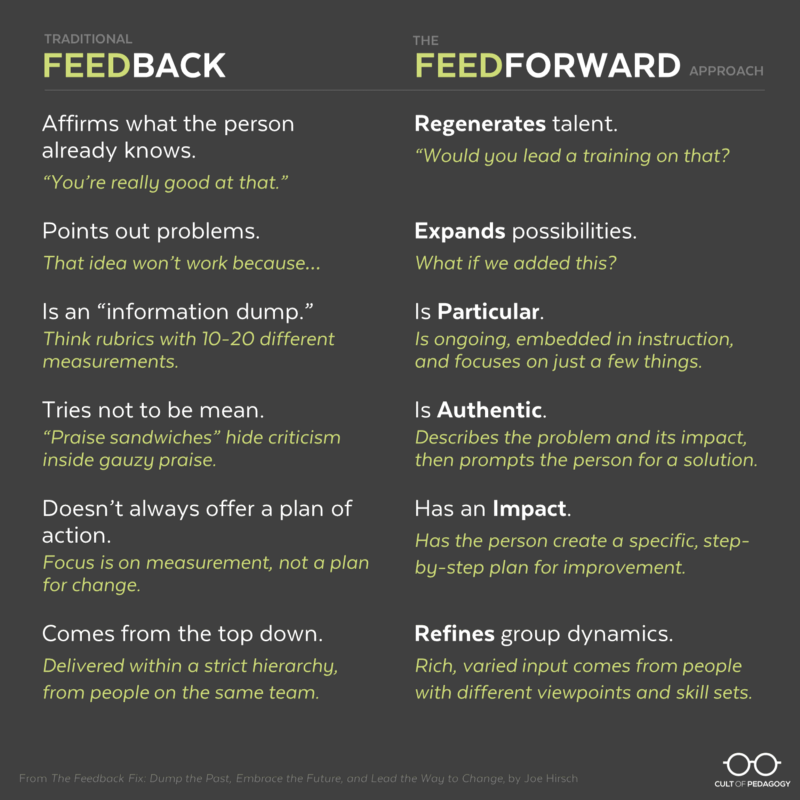The five pillars of feedback
One of the most important tasks of managers is to coach and give feedback. However, I think this task is not limited to managers. Each and every person on a team is responsible for giving and receiving feedback. Some feedback is given in the form of experienced team members coaching less-experienced members, but the common formal feedback is from a manager to a direct report.
Understanding how to give and receive quality feedback is a critical skill for any person. The way to give or receive quality feedback is fairly simple, but requires some practice. I will talk a bit about both ends of the feedback discussion.

Feedback by Trevithj CC BY-SA 3.0 from Wikimedia Commons
How does a good feedback giving look like?
- The feedback is given towards the behavior, not the person
- The expected behavior is explained
- The feedback looks forward and not backwards
- The feedback is timely
- The feedback is repeated
Lets look at each pillar on its own.
The feedback is given towards the behavior, not the person
When you give someone feedback, it is very important not to go ad hominem. A constructive feedback looks something in the lines of:
Hi, pushing code with tabs into the code base breaks our coding standards, this makes it hard to review code. Please make sure to add to your IDE spaces instead of tabs.
This feedback is very different from:
You broke our coding standards when you pushed that tab into the code base, this makes it hard to review code. Please make sure to add to your IDE spaces instead of tabs.
It is clear that focusing on the behavior, not the person improves the chances of your feedback will be well-received.
The expected behavior is explained
I will use the same example to explain this point.
Hi, pushing code with tabs into the code base breaks our coding standards, this makes it hard to review code. Please make sure to add to your IDE spaces instead of tabs.
Having the first sentence only does not give the person receiving the feedback a constructive way to fix the requested behavior. Once the expected behavior is explained it is easy to to see the person you are giving feedback to understands it and resonates with it.
The feedback looks forward and not backwards
Joe Hirsch wrote a book called The Feedback Fix, one of the points it highlights is not to dwell on what happened in the past, rather focus on the future. He calls his approach feedforward. Here is a summary of his points:

Feedforward. Source: All right reserved.
The feedback is timely
There is no point in coming to a person 3 months after something was done and giving feedback on it. That person will not remember and your feedback will be useless. Feedback given on a behavior needs to be given on the spot, or as close to it as possible.
The feedback is repeated
If the behavior is repeated, the feedback needs to be repeated. The main point in repeating the feedback is to make sure the message is conveyed. Consistency is crucial, one can’t give feedback on a behavior when noticed once, and not give feedback on other occurrences.
Those five pillars were for giving feedback, now i’d like to cover the five pillars of receiving feedback.
How does a good feedback receiving looks like?
- Ask for feedback, it is your opportunity to grow
- Listen, someone is devoting time to help you grow
- Think about the message conveyed
- Respond to the feedback
- Act on the feedback
Lets look at each pillar on its own.
Ask for feedback, it is your opportunity to grow
When on the receiving end of feedback, you would want to get constant feedback to help you improve. You need to ask for feedback that will actually help you. This means mainly ask for honest feedback, not some general niceness about how great you are.
Listen, someone is devoting time to help you grow
Listening to feedback is crucial if you want to get better. The usual response of people getting feedback is becoming defensive and not letting the person giving the feedback the full attention, rather preparing a response. If you listen carefully, you can learn quite a bit from the way the feedback is given.
Think about the message conveyed
After you listen carefully to the feedback do not respond immediately, think at least a few seconds before you respond. The person that has given you feedback has thought about what to say and how. Take the time to do the same, you may ask to take the time to think as well.
Respond to the feedback
The response you will give to the feedback giver is critical to the way you both will work forward on the behavior raised in the feedback. You will need to understand the behavior, the context and the expected change. Once you are clear on the feedback, respond professionally, and listen to a response if it comes.
Act on the feedback
Once you have decided what actions are needed you should act on it. If the expected behavior is explained it should be fairly easy to act on it. If you are not clear on the expected outcome, ask to clarify what is the expected action to take on the feedback.
To summarize, the main point to remember is feedback is a gift, when someone devotes time to give it, you should appreciate it. And when someone receives it, it should be taken as an opportunity to grow.